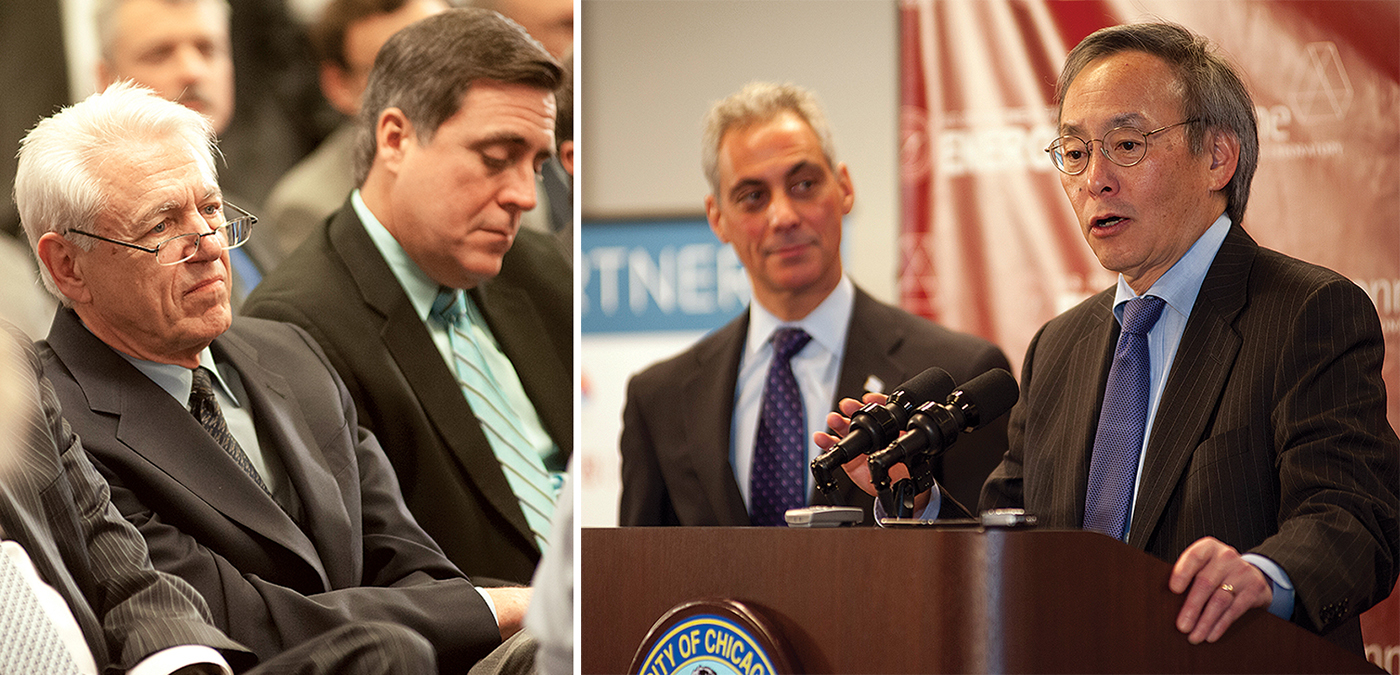UIC partner in $120 million energy project

PHOTOS: ROBERTA DUPUIS-DEVLIN
U.S. Secretary of Energy Steven Chu (right), with Mayor Rahm Emanuel, announces the Joint Center for Energy Storage Research, a $120 million federally funded research center directed by UIC professor George Crabtree (left) and led by Argonne National Laboratory.
UIC is a partner in a new $120 million federally funded energy research center, led by Argonne National Laboratory and directed by a UIC professor in physics and engineering, that will develop more powerful, lower-cost batteries.
The Batteries and Energy Storage Hub, known as the Joint Center for Energy Storage Research, received a five-year grant from the Department of Energy, with possible renewal for another five years.
U.S. Secretary of Energy Steven Chu announced the project at a downtown press conference Friday, where he was joined by Gov. Pat Quinn and Mayor Rahm Emanuel.
JCESR (pronounced “J-Caesar”) will combine the R&D firepower of five Department of Energy national laboratories, five universities and four private firms.
The center will be directed by Argonne senior scientist George Crabtree, UIC distinguished professor of physics and electrical and mechanical engineering.
“The JCESR award brings top battery scientists and engineers from around the country to tackle a major energy challenge: creating next-generation batteries with many times the energy density at much lower cost within the next five years,” said Crabtree, an internationally recognized leader in energy research.
“UIC is proud to be a partner in a project of this scope to meet a crucial national need for a game-changing technology,” said Chancellor Paula Allen-Meares.
“We’re looking forward to the journey of discovery, and confident that Professor Crabtree is just the person to lead it. He’ll have the full intellectual resources of the campus — particularly our strong physics and chemistry departments and College of Engineering — behind him.”
Next-generation battery and energy storage technologies for electric and hybrid cars and the electricity grid are critical to President Obama’s “all-of-the-above” energy strategy to reduce America’s reliance on foreign oil and lower energy costs for U.S. consumers, the Energy Department says.
“Based on the tremendous advances that have been made in the past few years,” Chu said, “there are very good reasons to believe that advanced battery technologies can and will play an increasingly valuable role in strengthening America’s energy and economic security by reducing our oil dependence, upgrading our aging power grid, and allowing us to take greater advantage of intermittent energy sources like wind and solar.”
The partnership between “world-leading” scientists and industry, Chu said, ensures that the advanced battery technologies the world needs “will be invented and built right here in America.”
Quinn will provide $5 million through the “Illinois Jobs Now!” capital construction plan to help build the JCESR facility on the Argonne National Laboratory campus in Lemont.
The governor has committed to working with the General Assembly to provide an additional $30 million in future capital funding for the building, which will be a nationwide center for energy storage research.
“Illinois is the birthplace of innovations that have changed the world, including the web browser, the cell phone and the ultrasound,” Quinn said.
Emanuel said he is focused on making Chicago “the electric vehicle and batteries capital of the nation,” as part of a “comprehensive strategy that will allow Chicago to lead in this industry, from conception to construction to implementation.”
In addition to Argonne, national labs partnering in JCESR include Lawrence Berkeley, Pacific Northwest, Sandia and SLAC National Accelerator Laboratory.
Other university partners include UIUC, Northwestern University, the University of Chicago and the University of Michigan.
Four industrial partners — Dow Chemical Company, Applied Materials Inc., Johnson Controls Inc. and Clean Energy Trust — will help clear a path to the marketplace for the advances developed at JCESR.
“JCESR provides key innovations not only in basic science and applied technology, but also in end-to-end management of the entire research and development chain,” Crabtree said.
“We will set the model for creating the energy innovations of the future.”
Energy Innovation Hubs are major integrated research centers, with researchers from different institutions and technical backgrounds, that combine basic and applied research with engineering to accelerate scientific discovery in critical areas.
The hubs are modeled on the scientific management principles of the Manhattan Project and the AT&T Bell Laboratories that developed the transistor.
JCESR is the fourth Energy Innovation Hub established by the Department of Energy since 2010. Other hubs focus on the modeling and simulation of nuclear reactors, improving the energy efficiency of buildings, and developing fuels from sunlight. A fifth hub, for critical materials research, was announced earlier this year and is still in the application process.
